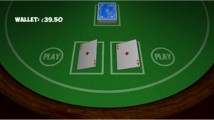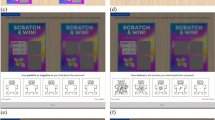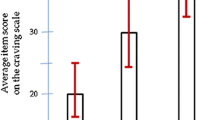Abstract
Loss-chasing is a central feature of problematic gambling, yet it remains a poorly conceived and understood concept. Loss-chasing is believed to stem from an erosion of cognitive control when gambling. The opportunity to gamble at significantly disparate stake sizes on a gambling activity is considered to be a risk factor for loss-chasing. This study investigated the impact of gambling at disparate stake sizes on executive processes integral to maintaining cognitive control when gambling, namely response inhibition and reflection impulsivity. Frequent adult non-problem gamblers (n = 32) participated in a repeated measures experiment; and gambled at three disparate stake sizes (£20, £2 and no stake per bet) on a simulated gambling task. Participants’ response inhibition performance and reflection impulsivity levels after gambling at various stake sizes were compared via a go/no-go task and information sampling task, respectively. Quality of decision-making i.e. the evaluation of available information to make probability judgements was impaired after gambling at higher stakes in comparison to lower stakes, indicating an increase in reflection impulsivity. No effect on response inhibition was observed. Although exploratory, this suggests that the opportunity for participants to substantially increase stake size on a gambling activity may be a risk factor for impaired cognitive performance when gambling, and perhaps create vulnerability for within-session loss-chasing in some players.

Similar content being viewed by others
References
American Psychiatric Association. (2000). Diagnostic and statistical manual of mental disorders (4th ed., text rev.).doi:10.1176/appi.books.9780890423349
Barkley, R. A. (1997). Behavioural inhibition, sustained attention and executive functions: constructing a unifying theory of ADHD. Psychological Bulletin, 121, 65–94. doi:10.1037/0033-2909.121.1.65.
Belin, D., Mar, A. C., Dalley, J. W., Robbins, T. W., & Everitt, B. J. (2008). High impulsivity predicts the switch to compulsive cocaine-taking. Science, 320, 1352–1355. doi:10.1126/science.1158136.
Billieux, J., Lagrange, G., Van der Linden, M., Lançon, C., Adida, M., & Jeanningros, R. (2012). Investigation of impulsivity in a sample of treatment-seeking pathological gamblers: A multidimensional perspective. Psychiatry Research, 198(2), 291–296. doi:10.1016/j.psychres.2012.01.001.
Blaszczynski, A. (2013). A critical examination of the link between gaming machines and gambling related harm. Journal of Gambling Business and Economics, 7(3), 55–76. doi:10.5750/jgbe.v7i3.818.
Blaszczynski, A., & Nower, L. (2002). A pathways model of problem and pathological gambling. Addiction, 97(5), 487–499.
Block, J., Block, J. H., & Harrington, D. M. (1974). Some misgivings about the matching familiar figures test as a measure of reflection impulsivity. Developmental Psychology, 10, 611–632.
Braverman, J., & Shaffer, H. (2010). How do gamblers start gambling: Identifying behavioural markers for high-risk internet gambling. European Journal of Public Health, 22(2), 273–278. doi:10.1093/eurpub/ckp232.
Breen, R. B., & Zuckerman, M. (1999). Chasing in gambling behavior: Personality and cognitive determinants. Personality and Individual Differences, 92, 1097–1111.
Campbell-Meiklejohn, D. K., Woolrich, M. W., Passingham, R. E., & Rogers, R. D. (2008). Knowing when to stop: The brain mechanisms of chasing losses. Biological Psychiatry, 63, 293–300. doi:10.1016/j.biopsych.2007.05.014.
Clark, L., Crooks, B., Clarke, R., Aitken, M. R. F., & Dunn, B. D. (2012). Physiological responses to near-miss outcomes and personal control during simulated gambling. Journal of Gambling Studies, 28(1), 123–137. doi:10.1007/s10899-011-9247-z.
Clark, L., Lawrence, A., Astley-Jones, F., & Gray, N. (2009a). Gambling near-misses enhance motivation to gamble and recruit win-related brain circuitry. Neuron, 61(3), 481–490. doi:10.1016/j.neuron.2008.12.031.
Clark, L., Robbins, T. W., Ersche, K. D., & Sahakian, B. J. (2006). Reflection impulsivity in current and former substance users. Biological Psychiatry, 60, 515–522. doi:10.1016/j.biopsych.2005.11.007.
Clark, L., Roiser, J. P., Robbins, T. W., & Sahakian, B. J. (2009b). Disrupted reflection impulsivity in cannabis users but not current or former ecstasy users. Journal of Psychopharmacology, 23, 14–22. doi:10.1177/0269881108089587.
Coates, E., & Blaszczynski, A. (2013). Predictors of return rate discrimination in slot machine play. Journal of Gambling Studies, 29(4), 631–645. doi:10.1007/s10899-013-9375-8.
Cohen, L. J., Nesci, C., Steinfel, M., Haeri, S., & Galynker, I. (2010). Investigating the relationship between sexual and chemical addictions by comparing executive function in subjects with pedophilia or opiate addiction and healthy controls. Journal of Psychiatry Practice, 16, 405–412. doi:10.1097/01.pra.0000390759.04581.7c.
Conversano, C., Marazziti, D., Carmassi, C., Baldini, S., Barnabei, G., & Dell’Osso, L. (2012). Pathological gambling: a systematic review of biochemical, neuroimaging and neuropsychological findings. Harvard Review of Psychiatry, 20, 130–148. doi:10.3109/10673229.2012.694318.
Corless, T., & Dickerson, M. (1989). Gamblers’ self-perceptions of the determinants of impaired control. British Journal of Addiction, 84, 1527–1537.
Delfabbro, P. H., Falzon, K., & Ingram, T. (2005). The effects of parameter variations in electronic gambling simulations: Results of a laboratory-based pilot study. Gambling Research, 17, 7–25. doi:10.1002/9781118316078.ch4.
Derryberry, D., & Reed, M. A. (2002). Anxiety-related attentional biases and their regulation by attentional control. Journal of Abnormal Psychology, 111, 225–236.
Dickerson, M., Hinchy, J., & Fabre, J. (1987). Chasing, arousal and sensation seeking in off-course gamblers. British Journal of Addiction, 82, 673–680.
Dixon, M. R., Maclin, O. H., & Daugherty, D. (2006). An evaluation of response allocations to concurrently available slot machine simulations. Behavior Research Methods, 38(2), 232–236. doi:10.1037/a0023630.
Ferris, J., & Wynne, H. (2001). The Canadian problem gambling index: Final report. Submitted for the Canadian Centre on Substance Abuse.
Fillmore, M. T. (2003). Drug abuse as a problem of impaired control: Current approaches and findings. Behavioral & Cognitive Neuroscience Reviews, 2, 179–197. doi:10.1177/1534582303257007.
Goldstein, R. Z., & Volkow, N. D. (2002). Drug addiction and its underlying neurobiological basis: Neuroimaging evidence for the involvement of the frontal cortex. American Journal of Psychiatry, 159(10), 1642–1652. doi:10.1176/appi.ajp.159.10.1642.
Goudriaan, A. E., Oosterlaan, J., deBeurs, E., & van den Brink, W. (2006). Neurocognitive functions in pathological gambling: A comparison with alcohol dependence, Tourette syndrome and normal controls. Addiction, 101, 534–547. doi:10.1111/j.1360-0443.2006.01380.x.
Goudriaan, A. E., Yucel, M., & van Holst, R. J. (2014). Getting a grip on problem gambling: What can neuroscience tell us? Frontiers in Behavioural Neuroscience, 8, 141. doi:10.3389/fnbeh.2014.00141.
Hester, R., & Garavan, H. (2005). Working memory and executive function: the influence of content and load on the control of attention. Memory & Cognition, 33, 221–233. doi:10.3758/BF03195311.
Holmes, E. A., Craske, M. G., & Graybiel, A. M. (2014). Psychological treatments: A call for mental-health science. Nature, 511, 287–289. doi:10.1038/511287a.
Kertzman, S., Lowengrub, K., Aizer, A., Vainder, M., Kotler, M., & Dannon, P. (2008). Go-no-go performance in pathological gamblers. Psychiatry Research, 161, 1–10. doi:10.1016/j.psychres.2007.06.026.
Kräplin, A., Dshemuchadse, M., Behrendt, S., Scherbaum, S., Goschke, T., & Bühringer, G. (2014). Dysfunctional decision-making in pathological gambling: Pattern specificity and the role of impulsivity. Psychiatry Research, 215(3), 675–682. doi:10.1016/j.psychres.2013.12.041.
Lawrence, A. J., Luty, J., Bogdan, N. A., Sahakian, B. J., & Clark, L. (2009a). Impulsivity and response inhibition in alcohol dependence and problem gambling. Psychopharmacology (Berl), 207(1), 163–172. doi:10.1007/s00213-009-1645-x.
Lawrence, A. J., Luty, J., Bogdan, N. A., Sahakian, B. J., & Clark, L. (2009b). Problem gamblers share deficits in impulsive decision-making with alcohol-dependent individuals. Addiction, 104(6), 1006–1015. doi:10.1111/j.1360-0443.2009.02533.x.
Lesiuer, H. R. (1979). The compulsive gambler’s spiral of options and involvement. Psychiatry, 42, 79–87.
Livingstone, C., Wooley, R., Zazryn, T., Bakacs, L., & Shami, R. (2008). The relevance and role of gaming machine games and game features on the play of problem gamblers. In Report for the Independent Gambling Authority (IGA). Adelaide: South Australia Independent Gambling Authority. http://www.iga.sa.gov.au/pdf/0801/Final%20report.Print.Feb08.pdf
O’Connor, J., & Dickerson, M. (2003). Definition and measurement of chasing in off-course betting and gaming machine play. Journal of Gambling Studies, 19, 359–386. doi:10.1046/j.1360-0443.2003.00232.x.
Parke, J., & Parke, A. (2013). Does size really matter? A review of the role of stake and prize levels in relation to gambling related harm. Journal of Gambling Business and Economics, 7(3), 77–110. doi:10.5750/jgbe.v7i3.819.
Potenza, M. N. (2014). The neural bases of cognitive processes in gambling disorder. Trends in Cognitive Sciences, 18(8), 429–438. doi:10.1016/j.tics.2014.03.007.
Quednow, B. B., Kuhn, K. U., Hoppe, C., Westheide, J., Maier, W., Daum, I., & Wagner, M. (2007). Elevated impulsivity and impaired decision-making cognition in heavy users of MDMA. Psychopharmacology (Berl), 189, 517–530. doi:10.1007/s00213-005-0256-4.
Sharpe, L. (2002). A reformulated cognitive behavioral model of problem gambling. A biopsychosocial perspective. Clinical Psychology Review, 22, 1–25. doi:10.1016/S0272-7358(00)00087-8.
Sharpe, L., Walker, M., Coughlan, M. J., Enersen, K., & Blaszczynski, A. (2005). Structural changes to electronic gaming machines as effective harm minimization strategies for non-problem and problem gamblers. Journal of Gambling Studies, 21(4), 503–520. doi:10.1007/s10899-005-5560-8.
Spada, M. A., & Roarty, A. (2015). The relative contribution of metacognitions and attentional control to the severity of gambling in problem gamblers. Addictive Behaviors Reports, 1, 7–11. doi:10.1016/j.abrep.2015.02.001.
Stevens, T., Brevers, D., Chambers, C. D., Lavric, A., McLaren, I. P. L., Mertens, M., et al. (2015). How does response inhibition influence decision making when gambling? Journal of Experimental Psychology: Applied, 21(1), 15–36. doi:10.1037/xap0000039.
Strakowski, S. M., Fleck, D. E., DelBello, M. P., Adler, C. M., Shear, P. K., McElroy, S. L., et al. (2009). Characterising impulsivity in mania. Bipolar Disorders, 11, 41–51. doi:10.1111/j.1399-5618.2008.00658.x.
van Holst, R. J., van den Brink, W., Veltman, D. J., & Goudriaan, A. E. (2010). Why gamblers fail to win: a review of cognitive and neuroimaging findings in pathological gambling. Neuroscience & Biobehavioural Reviews, 34, 87–107. doi:10.1016/j.neubiorev.2009.07.007.
Verdejo-Garcia, A., Lawrence, A. J., & Clark, L. (2008). Impulsivity as a vulnerability marker for substance-use disorders: Review of findings from high-risk research, problem gamblers and genetic association studies. Neuroscience and Biobehavioral Reviews, 32, 777–810. doi:10.1016/j.neubiorev.2007.11.003.
Volkow, N. D., Wang, G. J., Fowler, J. S., Tomasi, D., Telang, F., & Baler, R. (2010). Addiction: Decreased reward sensitivity and increased expectation sensitivity conspire to overwhelm the brain’s control circuit. BioEssays, 32(9), 748–755. doi:10.1002/bies.201000042.
Walker, M. B. (1992). The psychology of gambling. Oxford: Pergamon.
Wardle, H., Moody, A., Spence, S., Orford, J., Volberg, R., Jotangia, D., et al. (2010). British gambling prevalence survey 2010. Birmingham: Gambling Commission.
Winstanley, C. A., Eagle, D. M., & Robbins, T. W. (2006). Behavioural models of impulsivity in relation to ADHD: Translation between clinical and preclinical studies. Clinical Psychology Review, 26, 379–395. doi: 10.1016/j.cpr.2006.01.001
Wright, L., Lipszyc, J., Dupuis, A., Sathees, W. T., & Schachar, R. (2014). Response inhibition and psychopathology: A meta-analysis of go no go task performance. Journal of Abnormal Psychology, 123(2), 429–439. doi:10.1037/a0036295.
Author information
Authors and Affiliations
Corresponding author
Rights and permissions
About this article
Cite this article
Parke, A., Harris, A., Parke, J. et al. Understanding Within-Session Loss-Chasing: An Experimental Investigation of the Impact of Stake Size on Cognitive Control. J Gambl Stud 32, 721–735 (2016). https://doi.org/10.1007/s10899-015-9570-x
Published:
Issue Date:
DOI: https://doi.org/10.1007/s10899-015-9570-x




